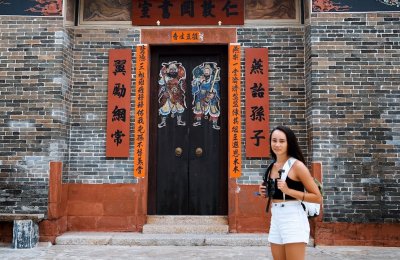A team of seven graduate students will take a two-week research trip to India while reporting on the country's public diplomacy efforts and posting entries on the already-live "India: Inside Out" blog.
The second-year Master's in Public Diplomacy students will be in New Delhi and Mumbai from Dec. 10-23 to meet with a range of stakeholders interested in how India is positioning itself to both foreign and domestic audiences. The objective of the website and blog is to spark a larger discussion on the relevance and value of public diplomacy within the international affairs and communications communities.
"It’s a strategic time to be looking at India because the government public diplomacy efforts there are still new," said Maya Babla, a Public Diplomacy student who helped organize the trip along with Aparajitha Vadlamannati. "Especially right now, India is relevant to every country in the world. It’s an emerging power. The question becomes, 'How much leadership can it exert.' That’s where public diplomacy plays an important role."
The students' research will appraise the role of India's public, private, nonprofit and media actors, as well as how these actors create the public diplomacy ecosystem in India. They will survey a wide range of diplomacies — from cultural to economic to citizen-powered initiatives — to understand how each is communicating the idea of India.
The objectives of this research trip are:
- Listen, take notes and learn what India is really all about. The students will ask questions such as: How do foreign publics understand India? How does that understanding (or lack thereof) inform policy toward India? How does India proactively communicate itself to the world, and what messages are most clearly being heard?
- Assess India’s public diplomacy strategy. Coming in with a fresh perspective, the students will offer their evaluation of what’s working, what’s not, and where future opportunities lie in conducting public diplomacy toward and from India.
- Explain what public diplomacy means. Why is a conversation about public diplomacy relevant to India? How can public diplomacy strategies be used to strengthen India’s role as a global player?
Vadlamannati said India has not yet exerted a comprehensive image of itself, but effective public diplomacy can change this.
"In India, there are so many different viewpoints, so it's difficult to make a singular image," Vadlamannati said. "There have been many labels placed on India from the rest of the world such as being an emerging power and a counter-weight to China, but India has not contributed to creating an image for itself. It has a chance as a country to say, 'You've given us many labels, but we see ourselves as this.'"
Student Jessica Castillo said that as the urban landscape changes in India, the ability to communicate new policies and explain these changes to both domestic and global audiences will become an important function of India's continued progress.
"In studying India's public diplomacy, I will be interested to learn how the nation's cities can be a springboard to reach its target audiences and improve the way in which those abroad understand the nation as a whole," Castillo said.
Each student will explore her or his own areas of expertise and interest before, during and after the trip.
Student Anna Dawson said she hopes to learn more about how public diplomacy efforts between Great Britain and India influence foreign policy between the two nations.
"This will lead to a greater understanding of the relationship between these historically intertwined countries," Dawson said.
Student Mona El Hamdani said she hopes to closely explore the type of relations India shares with the Arab World.
"I will be focused on examining and tracking public diplomacy initiatives, opportunities and challenges between India and certain Arab states, especially the ones located in the Gulf," Hamdani said.
Of the seven students, only Babla and Vadlamannati have previously been to India.
"We're all really excited to go," Vadlamannati said. "Our group has been talking about it non-stop. This trip won't just be about meetings — we'll also get a true cultural perspective. I've been before but this will be completely different. We'll be looking at important issues in meaningful ways."
The other Public Diplomacy students going on the trip are Hend Alhinnawi, who will explore the United Nations and USAID’s role in public diplomacy initiatives and how they relate to community development, education and women’s empowerment, and Jerry Edling, who will research India’s use of media in its public diplomacy efforts on and beyond the Indian subcontinent.
The Master's in Public Diplomacy, offered in partnership with USC Dornsife's School of International Relations, emphasizes the role of non-state actors, global public opinion, international news and international communication in the public diplomacy process. It is developing the next generation of leadership for international public service, business and nongovernmental organizations.
India: Inside Out blog
Meet the students
Master's in Public Diplomacy

